Attempting to answer two historical
mysteries/questions
Who was
Nefertiti
?
and
On tracking the Actual
Exodus
with R.D.Morningstar.
![]() Once
set the four pillars {Velikovsky & Osman, Freud
& Yates} of Akhnaton's identification, we may draw hypothesis on
a plateau of sound probability :
Once
set the four pillars {Velikovsky & Osman, Freud
& Yates} of Akhnaton's identification, we may draw hypothesis on
a plateau of sound probability :
![]() A
first glance at the scientific, archeologic and egyptologic evidences concludes
that the a Middle-Ages Western legendary figure
(HT3) has preserved the memory of the triple
identity (Akhnaton-Moses-Oedipus) of the
pharaoh Amenophis.4; and we know today that - whatsoever surprising and sometimes
unbelievable for the early readers - a second or close look a the
20th century data shows that there is not a single
contradiction between Akhnaton-Moses-Oedipus and the canonical knowledge
(Archeology, Bible, Mythology).
A
first glance at the scientific, archeologic and egyptologic evidences concludes
that the a Middle-Ages Western legendary figure
(HT3) has preserved the memory of the triple
identity (Akhnaton-Moses-Oedipus) of the
pharaoh Amenophis.4; and we know today that - whatsoever surprising and sometimes
unbelievable for the early readers - a second or close look a the
20th century data shows that there is not a single
contradiction between Akhnaton-Moses-Oedipus and the canonical knowledge
(Archeology, Bible, Mythology).
![]() With
this absence of incompatibility, the persistent contradictions appear like
a symptom which is also clarified by
Freud's psychoanalysis and Yates'
psychohistory.
With
this absence of incompatibility, the persistent contradictions appear like
a symptom which is also clarified by
Freud's psychoanalysis and Yates'
psychohistory.
![]() So
are we considering a thesis which is 1) abundantly documented and
argumented, 2) remarkably harmonious and much more explicative
in what is already known of the history of our civilization, 3) without
contradiction and discrepancy with this knowledge - and if my reader
at that point would feel uncomfortable, he should start with the chapter
regarding the symptom of the repressed
knowledge, which explain why the Akhnaton-Moses-Oedipus has been a surprise
for the 20th century ; for in this page we shall intend to go further.
So
are we considering a thesis which is 1) abundantly documented and
argumented, 2) remarkably harmonious and much more explicative
in what is already known of the history of our civilization, 3) without
contradiction and discrepancy with this knowledge - and if my reader
at that point would feel uncomfortable, he should start with the chapter
regarding the symptom of the repressed
knowledge, which explain why the Akhnaton-Moses-Oedipus has been a surprise
for the 20th century ; for in this page we shall intend to go further.
![]() We
shall take again the thesis to tackle two points which remains mysterious
for any scientific or traditional knowledge. Today two mysteries remain
: who was
Nefertiti and what has been
her role ? How exactly the
Exodus took place ?
We
shall take again the thesis to tackle two points which remains mysterious
for any scientific or traditional knowledge. Today two mysteries remain
: who was
Nefertiti and what has been
her role ? How exactly the
Exodus took place ?
![]() In
this page, I shall draw an hypothesis regarding these two point.
In
this page, I shall draw an hypothesis regarding these two point.
![]() About Nefertiti - a
famous Egyptian Queen of the end of the 18th Dynasty (1350B.C.)
- my friend David Gittens said once that she my have been a native from the
Hittite land we call today Turkey. I am not sure if he did not thought he
was making a mistake, but his idea stroke me, especially for I had never
hear of this possibility. All that we can be sure of, it that Egyptologists
do not know where Nefertiti was from, and that they never (for what I know)
mention that she could have been from the Aegean area.
About Nefertiti - a
famous Egyptian Queen of the end of the 18th Dynasty (1350B.C.)
- my friend David Gittens said once that she my have been a native from the
Hittite land we call today Turkey. I am not sure if he did not thought he
was making a mistake, but his idea stroke me, especially for I had never
hear of this possibility. All that we can be sure of, it that Egyptologists
do not know where Nefertiti was from, and that they never (for what I know)
mention that she could have been from the Aegean area.
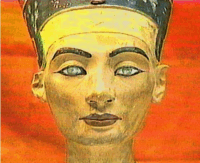
![]() What is not or never said is always
intriguing - especially when it is a possibility while everyone is looking
somewhere else. It is for example because Freud never said that Moses could
have been Akhnaton (he always said that he could have been close disciple
of Akhnaton) that I began to ponder the possibility, with certain results.
What is not or never said is always
intriguing - especially when it is a possibility while everyone is looking
somewhere else. It is for example because Freud never said that Moses could
have been Akhnaton (he always said that he could have been close disciple
of Akhnaton) that I began to ponder the possibility, with certain results.
![]() About the
Exodus - the Hebrew way out of Egypt, usually dated around
1300B.B. - another friend, Robert D. Morningstar, suggested a novel idea.
Robert actually believes that the Exodus was a complex long term event that
included the Amarnian period of Akhnaton/Moses. Morningstar believes that
the Historical Exodus is "embedded" in recorded Egyptian History; it has
not been recognized as such because it is has been called by another name,
i.e. Akhnaton's departure from Thebes and the establisment of the Amarna
period "in the wilderness".
About the
Exodus - the Hebrew way out of Egypt, usually dated around
1300B.B. - another friend, Robert D. Morningstar, suggested a novel idea.
Robert actually believes that the Exodus was a complex long term event that
included the Amarnian period of Akhnaton/Moses. Morningstar believes that
the Historical Exodus is "embedded" in recorded Egyptian History; it has
not been recognized as such because it is has been called by another name,
i.e. Akhnaton's departure from Thebes and the establisment of the Amarna
period "in the wilderness".
![]() This
idea also has never been considered in modern times.
I am going to wave these two hypothesis into a fiction, a novel, a fantasy,
to please the well learned people who always appreciate to be entertained
with a little delusion show. It may please also the ignorant people, for
they will feel at home... (for 15 years I explore
Akhnaton-Moses-Oedipus people who knew nothing
have always reacted as if it was a very natural hypothesis)
This
idea also has never been considered in modern times.
I am going to wave these two hypothesis into a fiction, a novel, a fantasy,
to please the well learned people who always appreciate to be entertained
with a little delusion show. It may please also the ignorant people, for
they will feel at home... (for 15 years I explore
Akhnaton-Moses-Oedipus people who knew nothing
have always reacted as if it was a very natural hypothesis)
![]() Here is the fiction - and
since we have to make sure that is it not a Science Function piece, I shall
make more precise what we do not
know.
Here is the fiction - and
since we have to make sure that is it not a Science Function piece, I shall
make more precise what we do not
know.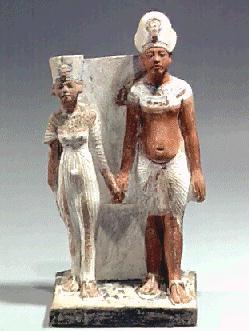
![]() Nefertiti
: She has been Akhnaton's wife, and probably Tutankhamon's
mother. Akhnaton and Nefertiti were both young when they married. They began
to reign in Thebes, while Akhnaton's parents were still alive. After
several temples had been built in Thebes for Nefertiti - who was ruling the
dawn of a
Nefertiti
: She has been Akhnaton's wife, and probably Tutankhamon's
mother. Akhnaton and Nefertiti were both young when they married. They began
to reign in Thebes, while Akhnaton's parents were still alive. After
several temples had been built in Thebes for Nefertiti - who was ruling the
dawn of a
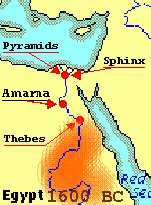 new
religion, Atonism, with Akhnaton, they migrate in a new city,
Amarna (The City of Horizon) to complete the full expression of their
cult.
new
religion, Atonism, with Akhnaton, they migrate in a new city,
Amarna (The City of Horizon) to complete the full expression of their
cult.
![]() The
origin of Nefertiti is unknown - some say that she was a princess sent
from Babylonia for the Father's harem - there are no prove, even no indication
to support this hypothesis - there are other very vague hypothesis, also
without foundation but a guess. The hypothesis being not made (censor?) that
she could have come from the Aegean Hittite land, or Crete, or other
tribe/kingdom of this area - this absence is part of the enigma.
The
origin of Nefertiti is unknown - some say that she was a princess sent
from Babylonia for the Father's harem - there are no prove, even no indication
to support this hypothesis - there are other very vague hypothesis, also
without foundation but a guess. The hypothesis being not made (censor?) that
she could have come from the Aegean Hittite land, or Crete, or other
tribe/kingdom of this area - this absence is part of the enigma.
![]() It
was at Amarna that Akhnaton and Nefertiti could promulgate in the most efficient
manner, the sole God Aton religion for the entire Egypt and its colonies.
During several years, Nefertiti was leading the ceremonies equally with Akhnaton.
She gave birth to several children. Then her image in Amarna gradually faded
- there is hardly any mention of her during the last days of Amarna. What
happened to her is unknown.
It
was at Amarna that Akhnaton and Nefertiti could promulgate in the most efficient
manner, the sole God Aton religion for the entire Egypt and its colonies.
During several years, Nefertiti was leading the ceremonies equally with Akhnaton.
She gave birth to several children. Then her image in Amarna gradually faded
- there is hardly any mention of her during the last days of Amarna. What
happened to her is unknown.
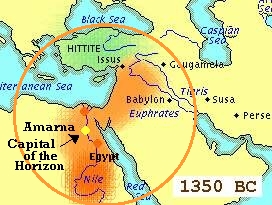
![]() .To
assess the situation of the Atonian scene, as for the definition of a behavior,
one may have a view of the context - in this case the 18th Dynasty which
began around1570B.C. with Ah-Moses then several Thot-Moses and ended shortly
after Akhnaton.
.To
assess the situation of the Atonian scene, as for the definition of a behavior,
one may have a view of the context - in this case the 18th Dynasty which
began around1570B.C. with Ah-Moses then several Thot-Moses and ended shortly
after Akhnaton.
|
|
![]() Once
we have assessed what was before Akhnaton
& Nefertiti's wedding - if we are looking for the best condition to
understand the mystery of their marriage, we shall also take advantage in
what happened after their disappearance:
Once
we have assessed what was before Akhnaton
& Nefertiti's wedding - if we are looking for the best condition to
understand the mystery of their marriage, we shall also take advantage in
what happened after their disappearance:
|
|
![]() We
can now summarize.
We
can now summarize.
![]() When
Akhnaton came to power, the entire world connected to Egypt (the Horizon
of Egypt) was under his control, except for a resistant area known as the
Hittite Kingdom (and/or some similar parts of the Aegean) - it was ideally
the reason to make a political wedding alliance. We don't know if it has
been the case - since we don't know where Nefertiti comes from - but we know
that Ramses married a Hittite princess in a way that was favorable to resume
Akhnaton's territorial policy. It would thus be unreasonable to neglect the
fact that Akhanton's wedding with Nefertiti could have been a first attempt
for this political maneuver.
When
Akhnaton came to power, the entire world connected to Egypt (the Horizon
of Egypt) was under his control, except for a resistant area known as the
Hittite Kingdom (and/or some similar parts of the Aegean) - it was ideally
the reason to make a political wedding alliance. We don't know if it has
been the case - since we don't know where Nefertiti comes from - but we know
that Ramses married a Hittite princess in a way that was favorable to resume
Akhnaton's territorial policy. It would thus be unreasonable to neglect the
fact that Akhanton's wedding with Nefertiti could have been a first attempt
for this political maneuver.
To summarize :
1) Because a failure is usually followed by a second
attempt.
2) Because is was logical to marry an Hittite princess
with Akhnaton.
3) Also because the Amarnian art - which is so peculiar
- shows striking similarities, or influence with the Aegean Art which was
for instance flourishing in Crete.
4) Because Nefertiti's statue may show an Eurasian
appearances.
5) Because also - in the context of a repressure -
historians never mention the Aegean origin of Nefertiti,
![]() For
these reasons there is a good probability that Nefertiti could be Hittite
(or related) - especially if we consider why the 'Oedipus complex' of
Akhnaton-Moses drove him to end his journey in Kolona. In thus becoming
Akhnaton-Moses-Oedipus, he rejoined the very place where its most repressed
part of his early influence came from.
For
these reasons there is a good probability that Nefertiti could be Hittite
(or related) - especially if we consider why the 'Oedipus complex' of
Akhnaton-Moses drove him to end his journey in Kolona. In thus becoming
Akhnaton-Moses-Oedipus, he rejoined the very place where its most repressed
part of his early influence came from.
![]() This
is leading us on the track of a certain claims which mention an integration,
in Akhnaton's drama, of some Northern mythological contribution - that we
may not consider yet, before a much more profound examination :
This
is leading us on the track of a certain claims which mention an integration,
in Akhnaton's drama, of some Northern mythological contribution - that we
may not consider yet, before a much more profound examination :
What shall we discover in building up our fiction
or hypothesis ? Let us resume the
fiction:
![]() Akhnaton's
father and his politicians, acknowledging the end of the military phase of
Egypt's recovery, planed to gather the spiritual forces of their new territory,
under a sole religion, inspired by an early original Egyptian monotheism
- the Aton Sun God worship. They presented Pharaoh's son as the Messiah who
was to be the leader of the new spiritual impulse.
Akhnaton's
father and his politicians, acknowledging the end of the military phase of
Egypt's recovery, planed to gather the spiritual forces of their new territory,
under a sole religion, inspired by an early original Egyptian monotheism
- the Aton Sun God worship. They presented Pharaoh's son as the Messiah who
was to be the leader of the new spiritual impulse.
![]() All
the countries (Babylonia, Syria, Palestine etc...) in the cultural compound
had more or less already blended their history with Egypt - a unique a new
blood was to be included. It was the Hittites. They had even not militarily
subdued - but looked as if they were ready for an alliance. For this project,
a princess was sent to Amenophis.3 (Akhnaton's father), to marry his young
son and future pharaoh.
All
the countries (Babylonia, Syria, Palestine etc...) in the cultural compound
had more or less already blended their history with Egypt - a unique a new
blood was to be included. It was the Hittites. They had even not militarily
subdued - but looked as if they were ready for an alliance. For this project,
a princess was sent to Amenophis.3 (Akhnaton's father), to marry his young
son and future pharaoh.
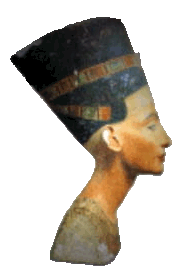
![]() This
princess was Nefertiti and, indeed, she brought with her an important influence
: when Akhnaton gained his independence as a ruler, he developed with Nefertiti
the full expression of Atonism in a new capital where the art and religious
expression showed a deep transformation of Egyptian style in art and way
of life. There is no indication that this new mentality was due exclusively
to Akhnaton - on the contrary the very 'familial' expression of the Amarnian
culture indicates that Akhnaton was probably able to honor the influence
of his wife - who was then the source for very Northern structure of
civilization, usually unknown in Egypt.
This
princess was Nefertiti and, indeed, she brought with her an important influence
: when Akhnaton gained his independence as a ruler, he developed with Nefertiti
the full expression of Atonism in a new capital where the art and religious
expression showed a deep transformation of Egyptian style in art and way
of life. There is no indication that this new mentality was due exclusively
to Akhnaton - on the contrary the very 'familial' expression of the Amarnian
culture indicates that Akhnaton was probably able to honor the influence
of his wife - who was then the source for very Northern structure of
civilization, usually unknown in Egypt.
![]() However,
Nefertiti was not sole responsible for the new capital, not more than Akhnaton
alone - but a political group (well named, by Freud, Neo-Egyptians)
was backing the
project.
However,
Nefertiti was not sole responsible for the new capital, not more than Akhnaton
alone - but a political group (well named, by Freud, Neo-Egyptians)
was backing the
project.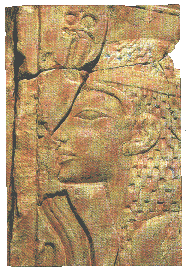 If my hypothesis is correct it is understandable that the first
temples to Aton - where Nefertiti is represented equal to Akhnaton - where
built in Thebes (as Amenophis.3 was still alive and ruling) - but the process
had to develop even further. It became a logical necessity that, in order
to give a chance to the New Empire, i.e. to include the whole
Eurasian/African Isthmus, Egypt would present a new Capital. This was intended
to thrust the pretended new era of the 'civilized world'. Once the alliances
were made, and the new religion preset, the final step was the physical capital
(which was incidentally built on one of the most ancient
site of the Egyptian history, yet outnoded until this 'Renaissance').
If my hypothesis is correct it is understandable that the first
temples to Aton - where Nefertiti is represented equal to Akhnaton - where
built in Thebes (as Amenophis.3 was still alive and ruling) - but the process
had to develop even further. It became a logical necessity that, in order
to give a chance to the New Empire, i.e. to include the whole
Eurasian/African Isthmus, Egypt would present a new Capital. This was intended
to thrust the pretended new era of the 'civilized world'. Once the alliances
were made, and the new religion preset, the final step was the physical capital
(which was incidentally built on one of the most ancient
site of the Egyptian history, yet outnoded until this 'Renaissance').
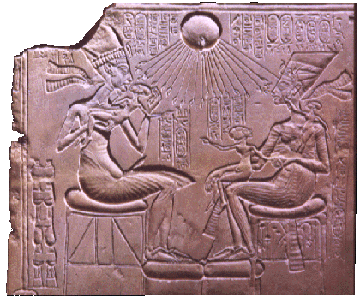
![]() By
the area known today as Assiout, Akhnaton and Nefertiti, the young couple
of a new Era in Mankind (according to their point of view) went certainly
through an extraordinary experience, inventing freedom and creativity. If
they had spoken English, John Lennon and Yoko Ono ruling the United Nation
in New York City, with the song 'Imagine' for their cultural dogma, may have
give an idea of the splendor they embraced in the early days of the 'City
of the Horizon'.
By
the area known today as Assiout, Akhnaton and Nefertiti, the young couple
of a new Era in Mankind (according to their point of view) went certainly
through an extraordinary experience, inventing freedom and creativity. If
they had spoken English, John Lennon and Yoko Ono ruling the United Nation
in New York City, with the song 'Imagine' for their cultural dogma, may have
give an idea of the splendor they embraced in the early days of the 'City
of the Horizon'.
![]() Alas,
this magnificent experience was soon darkened with difficulties - the Aegean
area was still too instable and the alliance with the Hittite proved to be
soon betrayed with attacks in Syria by Hittites troupes. Akhnaton refused
to send his armies against possible dissidents in the land of his wife. Moreover,
at the border, the threat was still far and indecipherable, while Akhnaton
and his Jewish relatives had not yet exploited all their trumps - there was
also internal difficulties in Egypt that can be summarized as follow:
Alas,
this magnificent experience was soon darkened with difficulties - the Aegean
area was still too instable and the alliance with the Hittite proved to be
soon betrayed with attacks in Syria by Hittites troupes. Akhnaton refused
to send his armies against possible dissidents in the land of his wife. Moreover,
at the border, the threat was still far and indecipherable, while Akhnaton
and his Jewish relatives had not yet exploited all their trumps - there was
also internal difficulties in Egypt that can be summarized as follow:
|
|
![]() These
factors suffice to draw now an hypothetical sketch of the events which took
place with the establishment of Atonism :
These
factors suffice to draw now an hypothetical sketch of the events which took
place with the establishment of Atonism :
2nd summarization
|
|
![]() One
should not be shocked to imagine Akhnaton traveling from Amarna to a crucial
conference on the Isthmus (Sinai and/or Arabia between
Africa & Eurasia) - one of the beautiful archeological piece
representing Tyie has been found on the Sinai, and it is well known that
there were Egyptian military and industrial places. If Akhnaton was
not paralyzed in Amarna, he had certainly good reasons to attempt a meeting,
instead of sending his troupes, where he could plan and readjust his global
strategy. From there, he could answer the need for practical laws - which
had to temper the abstraction of his sole and absolute religion.
One
should not be shocked to imagine Akhnaton traveling from Amarna to a crucial
conference on the Isthmus (Sinai and/or Arabia between
Africa & Eurasia) - one of the beautiful archeological piece
representing Tyie has been found on the Sinai, and it is well known that
there were Egyptian military and industrial places. If Akhnaton was
not paralyzed in Amarna, he had certainly good reasons to attempt a meeting,
instead of sending his troupes, where he could plan and readjust his global
strategy. From there, he could answer the need for practical laws - which
had to temper the abstraction of his sole and absolute religion.
![]() There
are good reason to think that in the context and, according to the development
of the mentalities at that age, a key-writing (what Fabre d'Olivet called
a Secret Alphabet, a pluri-dimensional set of letters) was the very
law that the King ruler could give in order to assemble the disparate ideographic
intellects of his subjects.
There
are good reason to think that in the context and, according to the development
of the mentalities at that age, a key-writing (what Fabre d'Olivet called
a Secret Alphabet, a pluri-dimensional set of letters) was the very
law that the King ruler could give in order to assemble the disparate ideographic
intellects of his subjects.
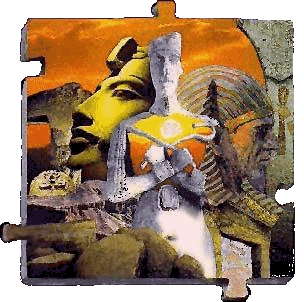
![]() In
the Sinai {my scholar reader will not
forget that this is a fiction, a novel} Akhnaton recollected
the knowledge of many of the most ancient, advanced and varied traditions
- he adjusted them with some very esoteric and usually secret Egyptian teachings.
He then established the linguistic media which was called at that time Table
of the Laws.Yet, in accomplishing this necessary maneuver, the Promethean
Akhnaton was threatened on the other side, by an excessive distance from
the Thebean control. When he came back to Amarna with the new project that
he had conceived with the 'sage' conference of the Isthmus, he found a
devastating situation.
In
the Sinai {my scholar reader will not
forget that this is a fiction, a novel} Akhnaton recollected
the knowledge of many of the most ancient, advanced and varied traditions
- he adjusted them with some very esoteric and usually secret Egyptian teachings.
He then established the linguistic media which was called at that time Table
of the Laws.Yet, in accomplishing this necessary maneuver, the Promethean
Akhnaton was threatened on the other side, by an excessive distance from
the Thebean control. When he came back to Amarna with the new project that
he had conceived with the 'sage' conference of the Isthmus, he found a
devastating situation.
|
|
![]() In
other words, if the first delivery of the Tables took place in Amarna, after
having counted on the Hebrew foundation to center his new politics. Akhnaton
realized that he had failed to assemble the puzzle of the New Empire. He
could not stay in Amarna - history shows that the City was closed to be destroyed
and razed to the ground. The only place he could go was back to the Sinai.
In anger Akhnaton left forever the City of his love and glamour , and
abandoned it to desolation.
In
other words, if the first delivery of the Tables took place in Amarna, after
having counted on the Hebrew foundation to center his new politics. Akhnaton
realized that he had failed to assemble the puzzle of the New Empire. He
could not stay in Amarna - history shows that the City was closed to be destroyed
and razed to the ground. The only place he could go was back to the Sinai.
In anger Akhnaton left forever the City of his love and glamour , and
abandoned it to desolation.
![]() However
the process could not be stopped - and the Aton enlightenment continued his
intellectual development.
However
the process could not be stopped - and the Aton enlightenment continued his
intellectual development.
![]() Once
the plague had ruined his policy, Oedipus' record tales that the falling
King realized that he had opted for a 'mother's influence' which contradicted
his global project. In Sophocles report, Tyresias reveals to the King that,
without knowing it, he had repudiated the principles of his life. Moses began
to admit and understand the visions of this seer, only when he went for the
second time in the Sinai.
Once
the plague had ruined his policy, Oedipus' record tales that the falling
King realized that he had opted for a 'mother's influence' which contradicted
his global project. In Sophocles report, Tyresias reveals to the King that,
without knowing it, he had repudiated the principles of his life. Moses began
to admit and understand the visions of this seer, only when he went for the
second time in the Sinai.
![]() Nefertiti
probably never joined him to his journey in the Sinai. When he went in the
Hebrew peninsula for the second time, it was under other conditions. He was
there alone -without wife or mother, but with his daughter, as Antigone was
with Oedipus in his exile. He heard of the final fall of his first endeavor
(Akhnaton) - as Sophocles tales the news he received about his two sons (Tut
and Semenkhare), and the death of both of them he could predict.
Nefertiti
probably never joined him to his journey in the Sinai. When he went in the
Hebrew peninsula for the second time, it was under other conditions. He was
there alone -without wife or mother, but with his daughter, as Antigone was
with Oedipus in his exile. He heard of the final fall of his first endeavor
(Akhnaton) - as Sophocles tales the news he received about his two sons (Tut
and Semenkhare), and the death of both of them he could predict.
![]() He
was also ready to achieve his second endeavor (Moses). I have written an
article which suggests which structure lays in the difference between the
first and te second version of the Table of the Laws. There is another article
which points to the function of the 'Orpheic' initiation in Akhnaton's story
- this was the part which had come with Nefertiti in the renovation of Atonism.
As he may have repudiated this initiation in the first delivery of the
'Tables' in the City of the Horizon - once he understood and could operate
the sublimation of his parental attachment, he was also ready to rejoin
ultimately the spirit he had betray in Nefertiti's remembrance.
He
was also ready to achieve his second endeavor (Moses). I have written an
article which suggests which structure lays in the difference between the
first and te second version of the Table of the Laws. There is another article
which points to the function of the 'Orpheic' initiation in Akhnaton's story
- this was the part which had come with Nefertiti in the renovation of Atonism.
As he may have repudiated this initiation in the first delivery of the
'Tables' in the City of the Horizon - once he understood and could operate
the sublimation of his parental attachment, he was also ready to rejoin
ultimately the spirit he had betray in Nefertiti's remembrance.
![]() Therefore,
once the adapted second version of the Tables were published, a task remained
for the Truth bearer - as the Bible says, he left the Sinai for a secret
destination; that we can understand today - recognizing Oedipus-Akhnaton
- being the land where his wife had come from. So the initiator of the Western
industry/civilization completed his operation as he revisited each places
of the complex symbol he had to compose.
Therefore,
once the adapted second version of the Tables were published, a task remained
for the Truth bearer - as the Bible says, he left the Sinai for a secret
destination; that we can understand today - recognizing Oedipus-Akhnaton
- being the land where his wife had come from. So the initiator of the Western
industry/civilization completed his operation as he revisited each places
of the complex symbol he had to compose.
![]() The
Primal Scene was over - ready for being memorized.
The
Primal Scene was over - ready for being memorized.
![]() I
know that every researchers before me have sabotage their initial disclosure.
Freud, Velikovsky, Osman, Bernal
I
know that every researchers before me have sabotage their initial disclosure.
Freud, Velikovsky, Osman, Bernal
![]() - therefore
I may do the same in extending the above hypothesis beyond the sound thesis
that I have waved during 15 hears.
- therefore
I may do the same in extending the above hypothesis beyond the sound thesis
that I have waved during 15 hears.
![]() To conclude thus risky
extrapolation, I shall just summarize:
To conclude thus risky
extrapolation, I shall just summarize:
![]() After a solid ground suggests
that Moses, Oedipus and Akhnaton were the same figure, I have tried to describe
what could be the explanation for two blind spots which remain in the historical
analysis: where was Nefertiti from, and where is the Amarnian phase mentioned
in the Bible.
After a solid ground suggests
that Moses, Oedipus and Akhnaton were the same figure, I have tried to describe
what could be the explanation for two blind spots which remain in the historical
analysis: where was Nefertiti from, and where is the Amarnian phase mentioned
in the Bible.
![]() As I have been waiting
for these 15 years for some honest scholar to invalidate the first triple
identification, I would like to assure my reader how much I will be longing
for him to show me where the above extension could be wrong or incompatible
- otherwise his/her silence would be too shameful.
As I have been waiting
for these 15 years for some honest scholar to invalidate the first triple
identification, I would like to assure my reader how much I will be longing
for him to show me where the above extension could be wrong or incompatible
- otherwise his/her silence would be too shameful.
NOTE - {Velikovsky & Osman, Freud & Yates} - back
|
This circular |

|
This summary |
NOTE - "not a single contradiction" - One good example is given with the Biblical affirmation that Moses was Hebrew; that is compatible with our present thesis, according to Osman's studies. - back
© CYBEK of New York, 1999.